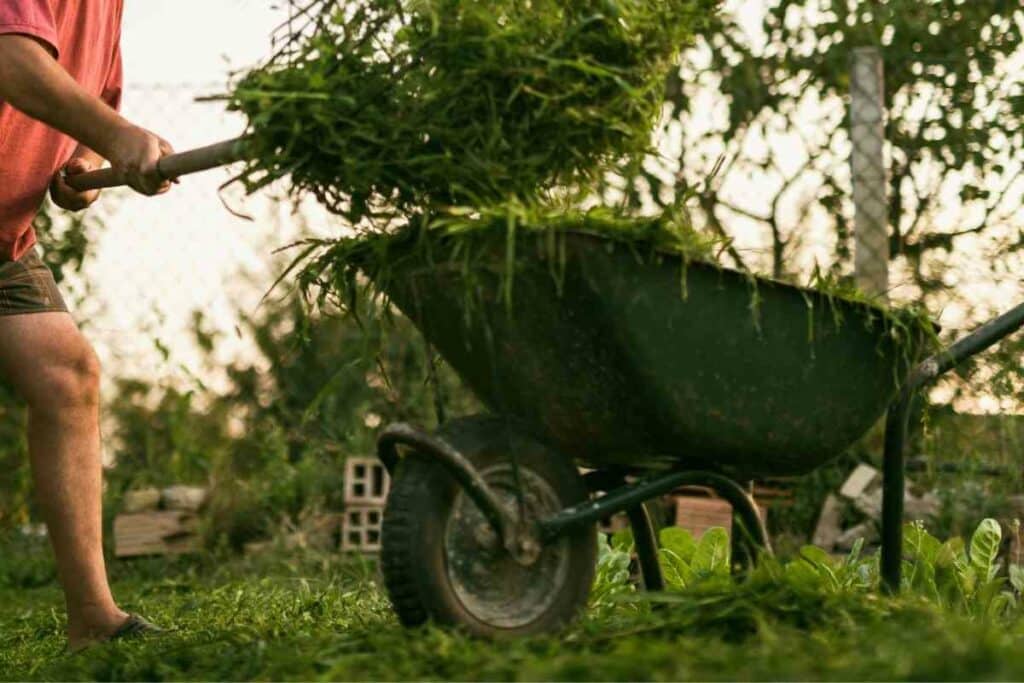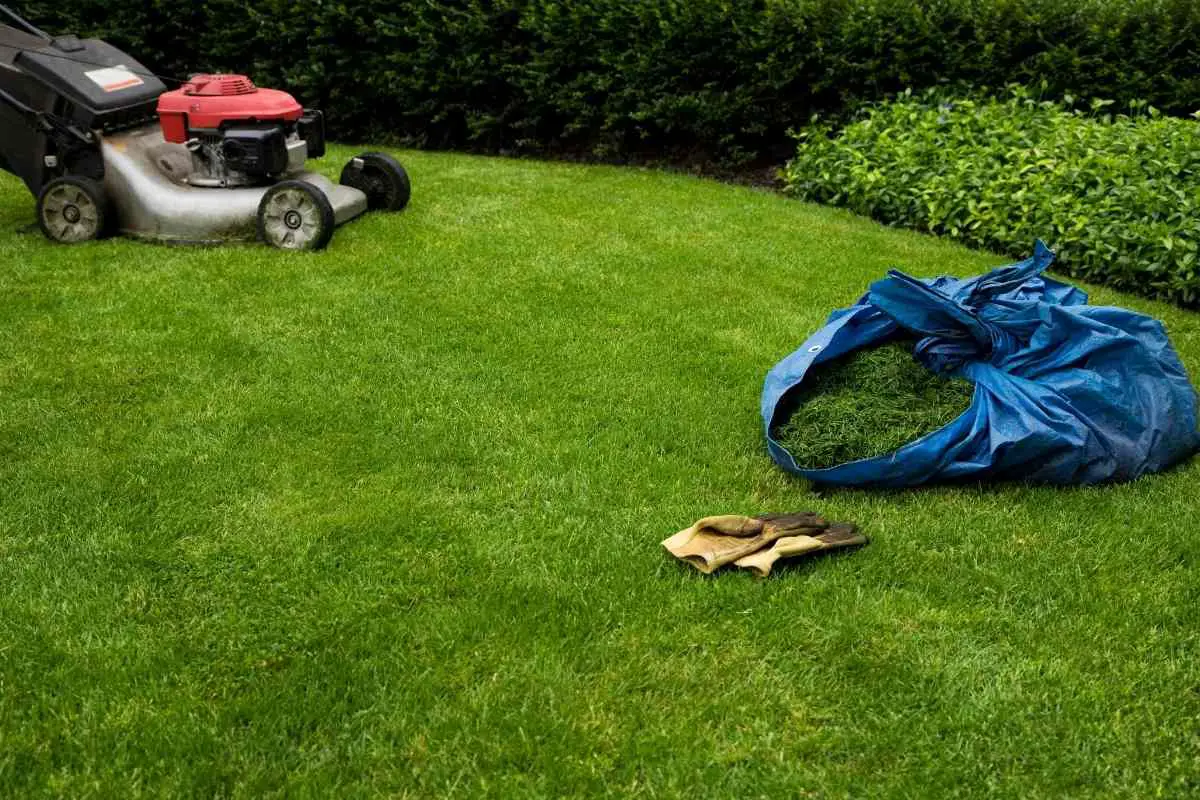You’ve cut your grass, and now you’re wondering what to do with the clippings. You might think of tossing them in the garbage.
However, this is not a good idea and it is actually not allowed in most regions. The best thing to do is to leave grass clippings of an inch or less in length on the lawn, where they will filter down to the soil surface and disintegrate quickly. Longer clippings should be removed because they can shade or smother the grass beneath, causing lawn damage.
That being said, there’s a lot more you could do with grass clippings than simply raking them up and tossing them in the garbage.
Utilizing grass clippings in your vegetable patch or flower bed can make it healthier while also repurposing your yard’s waste in an environmentally friendly manner.

It can improve your soil, retain moisture, and slowly decompose to become nutrient where your plants need it the most.
Grass clippings have a:
- nitrogen content of 4%
- phosphorus content of 1%
- the potassium content of 2%
- and trace levels of other plant elements
Thus, when they decay they provide food for microbial life in the soil.
Why Is It a Bad Idea to Dump Grass Clippings?
Grass clippings are highly hazardous. Dumping of any kind is prohibited, whether organic or inorganic.
People frequently use blowers or sweep grass clippings into the street. These grass clippings are washed down the drainage ditch and into the streams further polluting the environment.

Additionally, grass clippings and yard waste produce heat. This is caused by microscopic bacteria and fungi that feed on moist grass clippings.
Freshly cut grass spread across a lawn begins to rot, but you won’t notice the heat it produces until you rake the grass into a pile.
Have You Noticed: The larger the stack, the more heat is trapped, and the pile temperature rises. If these clippings are piled together with other garbage, it might potentially ignite.
How to Reuse Grass Clippings?
Grass clippings are far too valuable to be thrown away.
Leaving grass clippings on the lawn after mowing allows them to decay within a few weeks.
While it may appear to be a good idea to fasten a bag to the grass cutter to collect grass clippings and remove the annoying little green bits that is left behind, this is a bad idea.
Grass clippings should be placed throughout the lawn and used as a natural fertilizer.
Grass clippings decay quickly and bring back crucial nutrients to the soil.
Few lesser-known facts:
- Grass clippings and extra yard waste account for 12% of hard waste in landfills across the United States. During high season, that percentage can rise to 50%.
- Throwing yard waste and grass clippings is both wasteful and costly.
- Instead of using yard waste as an organic fertilizer for their lawns, taxpayers spend a lot of money collecting and transporting it to the landfills.
Things to Consider When Grasscycling
When the grass is dry, cut it.
Mowing a wet yard is difficult because the grass is weighty and will not provide a good cut. A dry cut will aid in the efficient dispersal of clippings.
Keep the mower’s blade sharp. A sharp blade promotes a clean cut, which keeps diseases and insects at bay in the yard.
If there is too much growth in between clippings, lift the mower height and slowly lower it for subsequent clippings.
A dramatic cut will shock the grass, whereas a moderate cut will keep the grass healthy.
After mowing the grass, there is no need to collect the grass clippings. Leave them alone; the small clippings will eventually fall into the deeper surface of your lawn.
If your yard has been herbicide-treated and you intend to use grass clippings as mulch, wait for at least three cutting grass sessions before using the grass clippings.
Benefits of Reusing Grass Clippings
- It helps you save time. Lawn mowing will become far more convenient and quicker. You won’t need the mower bag when you mow, which implies less time spent emptying it. Cutting the grass becomes simpler, easier, and takes less time.
- Grass clippings return crucial nutrients to the soil, and less fertilizer will be required to maintain a colourful lawn.
- Less water is wasted because the clippings aid in retaining moisture in the soil and maintaining a healthy lawn.
- There will be no unnecessary bagging; you will require less work.
- You will use Grass clippings in a green manner; less waste will be generated.
| Things to do with grass clippings | Things not to do with grass clippings |
|---|---|
| Mulch with Grass Clippings: Mulching around vegetables, flowers, shrubs, and trees in the yard helps in controlling weeds and regulates soil temperature and moisture. | Burning grass clippings: Burning produces smoke, which can annoy neighbors, and emits carbon dioxide into the atmosphere. |
| Make compost from grass clippings: They are a good source of nitrogen, and when combined with carbon-rich materials, they degrade quickly. | Throwing grass clippings in the garbage: When organic material degrades, methane is produced, which can ignite in massive amounts. |
| Leave grass clippings out on the lawn: As they decompose, they return nitrogen and other nutrients to your lawn. | |
| Make liquid fertilizer from lawn clippings: Grass clippings can also be converted into organic liquid fertilizer. | |
| They are excellent weed repellent: Weeds can be prevented by laying down grass clippings beneath the base of your hedges and bushes. |
How to Dispose Grass Clippings?
1. Composting or Mulching Grass Clippings
Nitrogen-rich grass clippings make excellent compost materials.
When added to a compost pile, it produces a balanced carbon and nitrogen content and high-quality fertilizer. As a result, your plants will grow healthier.
In addition to compost, you can use grass clippings to make mulch. Mulch not only adds nutrients to your soil but can also prevent weeds from growing.
2. You Can Leave them on Your Lawn
The best way to get rid of grass clippings is to leave them in your yard.
In this case, you should mow the grass regularly rather than wait until it grows too long.
Allowing grass clippings to fall to the ground will naturally help feed the soil in your yard. As a result, your lawn will be healthier.
This is also the best alternative because it does not necessitate any additional effort.
You have to cut the grass regularly so that the grass clippings don’t look disorganized and unkempt in your yard.
Best Strategy: This method is inexpensive and simple, but it is also more financially beneficial because it can naturally fertilize your soil.
3. Give Away Grass Clippings
If you live near a farm, you may be willing to donate the grass clippings to them.
They can typically use grass clippings as animal feed or to make compost.
Aside from farmers, you can also speak with a local gardener. Grass clippings are also commonly used to make compost or mulch.
4. Use Them to Top Dress Raised Beds
You can also use grass clippings as a top dressing in raised garden beds.
They aid in the retention of moisture in your beds, weed suppression, and organic fertilizer addition to your plants.
Try spreading a few inches across the surface of the beds.
The height of the mulch will decrease as the clippings decay. Throughout the growing period, add more as needed.
5. Deliver Grass Clippings to a Local Disposal Facility
If your regular garbage disposal service allows it, the simplest way to dispose of grass clippings is to place them in your yard waste bin.
However, because not all waste disposal organizations want to haul your lawn trash, you should separate it from your regular trash can.
Aside from that, some trash collection companies can charge extra for yard waste.
As a result, you may need to consult with the garbage collector first.
Final Thoughts
Leaving grass clippings on the yard does not result in thatch, a layer of partially decomposed grass-plant parts between the live grass and the soil.
Grass clippings are mostly water, so as long as you cut the grass at the proper height regularly, they will degrade and disappear quickly.
If your yard has any illness or fungal infestation, such as Brown Patch Lawn Disease, do not let grass clippings fall on it after mowing.
This will only motivate the disease or fungus to continue to spread, allowing it to infect a wider area of your lawn.
By removing the clippings, you are assisting in the reduction of the population level of deleterious organisms.
Also Useful
- 7 Centipede Grass Problems You Might Be Having
- 8 Cheap Ways to Cover Dirt in Your Backyard
- Are Grass Seeds Bad for Dogs?
